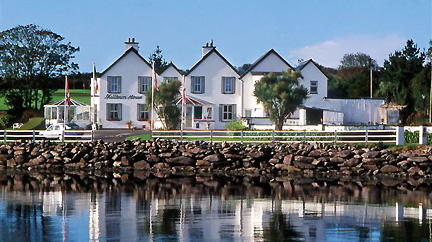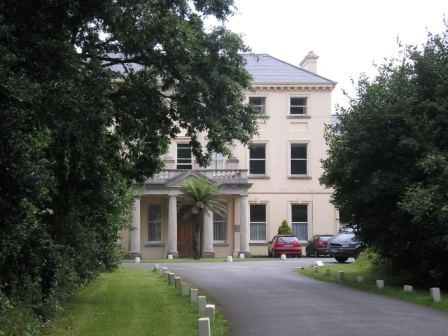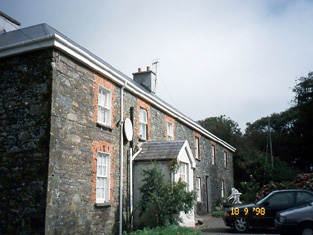Ballintaggart House
Houses within 15km of this house
Displaying 20 houses.
Houses within 15km of Ballintaggart House
Displaying 20 houses.
| House name | Description | |
|---|---|---|
| Bunnanier | Francis Bland held a house valued at almost £4 together with 500 acres at the time of Griffith’s Valuation. Bary states that it was built in the late 1830s, probably as a shooting lodge. The Ordnance Survey Name Books describe it as "a handsome cottage". The National Inventory of Architectural Heritage consider it as a Glebe House. It is still extant. | |
| Ballintermon House | At the time of Griffith’s Valuation, Timothy Moriarty was leasing a property valued at almost £6 from the Earl of Cork’s estate. The Ordnance Survey Name Books of the 1830s mention that the house was built by Timothy Moriarty in 1820. Bary states that this is an ancient house, associated with the Moriarty family for many years. It is still extant. In the same townland Timothy Griffin was leasing Manor Court House [Q602022] from the Moriartys. It is described as "in ruins" on the 1st edition OS map and was valued at £1 15s in 1852. | |
| Fermoyle House | At the time of Griffith’s Valuation, Robert C. Hickson was leasing this house, valued at £28, from the Earl of Cork’s estate. Lewis notes Fermoyle House as the seat of J. Hillyard in 1837. In 1906 it was the property of George A. Hickson and valued at £25. Bary states that the house was, for a long period, associated with the Conway Hickson family. It is still standing and inhabited. |

|
| Brackloon House | At the time of Griffith’s Valuation, James Hickson was leasing this house, valued at £10, to James Moriarty. On the 1st edition Ordnance Survey map this property is labelled "hotel". In 1786 Wilson refers to "Bracklow-Inn" on this road. |

|
| The Grove | At the time of Griffith’s Valuation, Mrs. John Hickson was leasing this house, valued at over £27, from Reverend Maurice Townsend. 1n 1837, Lewis describes the property as formerly belonging to the Knight of Kerry. It is most likely the property at Dingle referred to by Wilson in 1786. It is no longer extant. A new community school for Dingle has been constructed near the site. | |
| Farranredmond | At the time of Griffith’s Valuation, Robert C. Hickson was leasing this house, valued at almost £6, from Patrick Stack. The latter held other property in the same townland from Lord Ventry’s estate. Buildings are still extant at the site. | |
| Milltown House | At the time of Griffith’s Valuation, Robert Hickson was leasing a house & mill, valued at almost £29, from the representatives of Walter Hussey. A large house, now functioning as a guesthouse, is located at the site. |

|
| Burnham | Lord Ventry held a house valued at £49 at Burnham East, barony of Corkaguiny, at the time of Griffith’s Valuation. Lewis mentions that the family lived for much of the time in England and the house was occupied by their agent, David Thompson. The Ordnance Survey Name Books indicate that the house had been built c.1790 at a cost of £4000. Wilson, however, refers to Burnham as the seat of Thomas Mullins in 1786. Later, members of Lord Ventry’s family resided there. It was still owned by Lord Ventry in 1906 when the house was valued at £80 and ancillary buildings at Burnham West valued at £28. The property was sold to the Land Commission in the 1920s and the house became an Irish speaking secondary school for girls, Coláiste Íde, which is still in operation. |

|
| Farranakilla | At the time of Griffith’s Valuation, James Hussey was leasing a property valued at £26 to Edward Day Stokes. In 1837 Lewis records it as the seat of P.B. Hussey. Bary states that Farrankilla House was built c.1800 by the Hussey family. Edward Day Stokes, to whom it was leased at the time of Griffith’s Valuation, was an agent for both Lord Ventry and the Townsend estate. The house was sold several times in the 20th century. It is still extant. | |
| Ballybeg | At the time of Griffith’s Valuation, Michael Galway was leasing a house valued at almost £6 at Ballybeg to Michael Manning. Leet records Mat. Moriarty as the proprietor in 1814. Bary indicates that the house had disappeared by the end of the nineteenth century. | |
| Lough House | At the time of Griffith’s Valuation, James Hussey was leasing a property valued at £22 to Edward Hussey. Bary states that the house was built in the 1840s and that it was later used by Irish Church Missions in Dingle. In 1906 it was their property and valued at £22. It is still extant and occupied. Nearby is a tower known as Hussey's Folly, built around 1845. |

|
| Cloghane | At the time of Griffith's Valuation, Rev. Timothy Moriarty was leasing the property at Cloghane from the Irish Church Missions when it was valued at £18 10s. MacDonagh indicates that Moriarty was a native of Dingle who had converted to the Church of Ireland. | |
| Hill Ville | At the time of Griffith’s Valuation, this house, valued at almost £12, was being leased from Lord Ventry’s estate by Thomas de Moleyns. Lewis refers to HillVille as the seat of John Hickson. Bary quotes O'Donovan who claims that this house was built as a lodge, in 1833, by James Hickson. In 1906 it was still part of Lord Ventry's estate and valued at £16. It is now Crutch's Country House Hotel. |

|
| Kilfarnoge | Richard Leahy held a property valued at almost £7, together with over 240 acres, at Kilfarnoge, barony of Corkaguiny, at the time of Griffith's Valuation. The property is labelled as Coon on the 1895 OS map. | |
| Liscarney | At the time of Griffith's Valuation, Edward Hussey was leasing a property at Liscarney to the Dingle Poor Law Guardians as an auxilliary workhouse. Lewis notes Liscarney, in the parish of Ballyduff, as the seat of T.B. Hussey in 1837. However, this appears to be Liscarney House, leased by Hussey to Brigid Flaherty at the time of Griffith's Valuation, and valued at £1. It is not shown on the 25-inch Ordnance Survey map of the 1890s. | |
| Ballyameen | At the time of Griffith's Valuation, Rev. Thomas Goodman was leasing this property, together with over 100 acres, from Lord Ventry's estate. It was valued at £4 52. In 1814, Leet had recorded it as the residence of Rev. John Goodman. This house is no longer extant. | |
| Kilmurry (Corkaguiny) | In 1906 Lord Ventry's estate owned this property valued at £6 5s.At the time of Griffith's Valuation, much of the property in this townland was held by Thompson, Lord Ventry's agent. A house valued at £1 4s was being leased from them by Richard Searl and another, together with 48 acres, by Laurence Sullivan. The coastguard station was also located there. . | |
| Caheratrant | In 1906 Lord Ventry's estate owned a property valued at £5 5s at Caheratrant. This may refer to the Coastguard Station. At the time of Griffith's Valuation, much of this area was held by David Thompson, Lord Ventry's agent. | |
| Gortmore | At the time of Griffith's Valuation, Rev. Isaac Seale was leasing this property from the Ecclesiastical Commissioners, when it was valued at £13 15s. In 1840, the Ordnance Survey Field Name Books indicate that Lord Ventry had given this property "for use as a missionary clergyman's residence". The house is still extant. |

|
| Clooncurra | In 1786 Wilson states that Clooncurra was the seat of Mr. Hussey. At the time of Griffith's Valuation, this townland was part of the Hickson estate and let in two substantial farms, with houses valued at £1 5s and £1 10s respectively. Modern farm buildings are visible at the site. |

